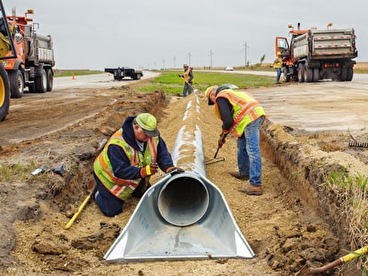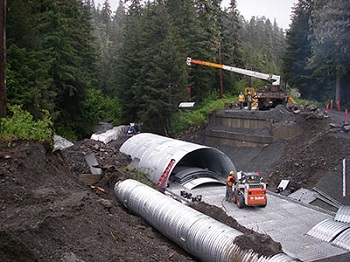Safe and Efficient Tree Removal Providers
Safe and Efficient Tree Removal Providers
Blog Article
Culvert Setup Made Easy: Step-by-Step Overview for Success
Installing culverts might appear like a simple job, yet ensuring a successful outcome needs careful planning and execution. From selecting the appropriate culvert dimension to integrating correct water drainage steps, each step in the installation procedure plays a vital function in the performance and durability of the culvert system. By adhering to a systematic method and paying focus to essential details, the installation can continue smoothly, reducing prospective problems down the line. Stay tuned to uncover the necessary steps and considerations that can make culvert installation a smooth and effective endeavor.
Choosing the Right Culvert Dimension
Picking the proper culvert dimension is critical for ensuring reliable water flow and architectural honesty in culvert setup jobs - Pad Construction. The size of the culvert straight affects the flow capacity of water with the framework. A culvert that is too small can cause flooding and overflow, while one that is too large may lead to decreased water speed, potentially triggering debris accumulation and clogs
To determine the right culvert dimension, variables such as the watershed area, peak flow rates, and hydraulic efficiency need to be meticulously thought about. Estimations based upon these criteria help in selecting a dimension that can appropriately manage the expected water quantity while lessening the threat of obstructions and architectural failing.
It is crucial to get in touch with engineering guidelines and criteria to ensure that the picked culvert dimension satisfies the job demands and regional regulations (Pad Construction). By picking the right culvert size, task supervisors can maximize water flow, protect against potential concerns, and boost the overall efficiency and durability of the culvert installment
Preparing the Installment Site
Efficient culvert installation necessitates meticulous prep work of the installation site to guarantee optimum structural support and performance. Prior to starting the installation procedure, it is vital to remove the website of any kind of particles, vegetation, or blockages that can restrain the culvert's placement. Making certain a level structure is essential for the appropriate placement and stability of the culvert. This may involve rating the website to produce a smooth, also surface area that can adequately support the weight of the culvert and any type of awaited tons. In addition, appropriate compaction of the soil under the culvert is essential to stop resolving or shifting in time.
In addition, it is necessary to consider variables such as dirt composition, groundwater levels, and ecological influences when preparing the installment site. Carrying out a thorough site assessment can help determine any type of potential difficulties or threats that may impact the culvert's efficiency. By taking the time to prepare the installment site properly, you can help ensure an effective culvert installment that fulfills structural needs and makes certain long-lasting performance.
Putting the Culvert Appropriately

The quality at which the culvert is put is critical for keeping a proper slope for water circulation. A gradual incline assists prevent pooling and promotes effective drain. Additionally, the culvert should be oriented properly to make certain that the inlet and electrical outlet are in the proper locations. This alignment is important for the culvert to work effectively in taking care of water flow.
Backfilling and Compacting the Soil
Correct backfilling and compaction of the soil around the culvert is crucial to make certain stability and avoid possible concerns in the future. When the culvert is appropriately put, the following crucial step is to backfill the location around it with ideal material. The backfill product must be free from rocks, debris, and raw material to stay clear of damage to the culvert. It is suggested to make use of granular material such as sand or crushed rock for backfilling, as it offers great drainage and compaction buildings.
Compaction aids in reducing the chances of settlement and makes sure uniform assistance around the culvert. It is vital to small the soil equally on all sides of the culvert to keep its structural honesty.
Appropriate backfilling and compaction not just provide security to the culvert yet likewise assist in avoiding dirt disintegration and maintaining the longevity of the culvert system.
Ensuring Correct Drain Combination
Integrating reliable drainage solutions plays a crucial function in the total performance and longevity of culvert setups. Appropriate drain combination is essential for handling water circulation, stopping disintegration, and guaranteeing the architectural integrity of the culvert system. To attain this, it is essential to create a detailed drainage plan that takes into consideration aspects such as the quantity of water expected, the topography of the area, and the kind of dirt present.

Additionally, including features like erosion control actions, such as riprap or Pad Construction plant life, can better improve the performance of the drainage system. By meticulously preparing and executing these drainage options, culvert installments can operate efficiently and withstand the examination of time.
Final Thought
To conclude, appropriate culvert installation is critical for maintaining effective water drainage systems. By choosing the appropriate culvert size, preparing the installation website, putting the culvert appropriately, backfilling and condensing the dirt, and ensuring proper drain assimilation, success can be accomplished. Adhering to these actions will assist make sure the longevity and efficiency of the culvert, inevitably adding to the overall success of the water drainage system.
Report this page